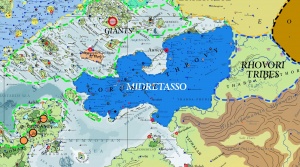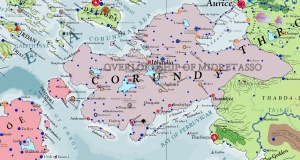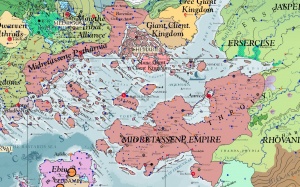Difference between revisions of "Midretasso"
Trismegistus (talk | contribs) m (→History) |
Trismegistus (talk | contribs) m |
||
| (15 intermediate revisions by the same user not shown) | |||
| Line 1: | Line 1: | ||
| − | Midretasso is the ancient civilization of [[Corundy]] that succeeded and inherited the rich tradition of [[Kalama]]. Midretasso was ruled by over-kings of | + | Midretasso is the ancient civilization of [[Corundy]] that succeeded and inherited the rich tradition of [[Kalama]]. Midretasso was ruled by over-kings of Midrinksi extraction, with priests and philosophers of Kalaman heritage. Midretasso grew to rule most of the eastern [[Pallathantic Region]] in ancient times. The unstoppable armies and navies of the [[Yophenthean Empire]] defeated the Midretassene Empire through a series of battles, most notably the [[Battle of Siul]] where the Yophenthean navy and naval allies defeated the Midretassene Navy. By the end of the sixth century, Yophenthea had conquered all Midretasso. The heritage of Midretasso, along with the much older Kalaman civilization, survives in [[Corundy]] and especially eastern Corundy ([[Zamiria]]) as part of the [[Tassan Civilization]]. |
=History= | =History= | ||
| − | [[File:MapKalama8thcenturyAS.jpg|thumb|300px|Migration of [[ | + | [[File:MapKalama8thcenturyAS.jpg|thumb|300px|Migration of [[Midrinksi Tribes]] into Kalama in the eighth century before [[Salmakhamer]]. Midrinksi tribes shown in blue. [[Kalama]]n remnant city-states and tribes shown in purple.]] |
{{See also|List of the Over-Kings of Midretasso}} | {{See also|List of the Over-Kings of Midretasso}} | ||
| − | The [[ | + | The [[Midrinksi Tribes]] of western [[Lucacia]] entered in successive waves into eastern Kalama around the eighth century before [[Salmakhamer]]. Midrinksi tribes through conquest and settlement spread from Lucacia into eastern Corundy and thence to central and western Corundy by the time of Salmakhamer. For the next eight hundred years, the Midrinksi tribes dwelt alongside the remnants of Kalaman civilization that persist to this day. Midrinksi city-states expanded their power through these centuries through conquest and treaty. A blending of Midrinksi and Kalaman culture established the foundation of later Midretassene Civilization, with great honor given to the much more ancient Kalaman contribution. In the early second century before [[Salmakhamer]], the Midrinksi city-state of [[Flampesha]], united all of eastern Corundy. By the mid second century before Salmakhamer, the Jaithan power of the city-state of [[Cetibrymio]] (Kathyabrumya), came to conflict with Flampesha. The two cities eventually united, combining the military power of the Midrinksi tribes with the religious and scientific knowledge of the Jaithan people into the core state that became Midretasso. By the time of the first century after [[Salmakhamer]], Midretasso had united all of the Corundian Peninsula under the rule of the first [[Over-King of Midretasso|Over-King]], [[Uturnus I|Uturnus]]. Ancient Midretassenes developed a powerful empire that spread rulership throughout the Corundian peninsula, [[Lucacia]], [[Ithatia]], the [[Shadevan Delta]], [[Agogia]], western [[Erserce]], and [[Dúrandwor]]. Midretassenes employed a well organized military and wielded powerful necromancy. In 287 AI, the Midretassene Navy defeated the Elystrine Navy in the [[Battle of Deliopian Strait]]. In 415 AI, the Midretassene army defeated an alliance of Moigthe in southern [[Pytharnia]] in the [[Battle of Curchása]], thus securing Midretassene control of [[Dúrandwor]]. By the late fifth century, Midretasso came up against the power of the [[Yophenthean Empire]], with both empires striving to exert greater influence over the [[Moigthe Tribes]] of Pytharnia. In 513 AI, the [[Battle of Siul]] saw the Yophenthean defeat of the Midretassene Empire and marked the beginning of the decline and conquest of Midretasso in the same century. |
| − | [[File:MapMidretasso1stcentury.jpg|thumb|300px|First Century Midretasso was spread through | + | [[File:MapMidretasso1stcentury.jpg|thumb|300px|First Century Midretasso was spread through Lucacia and Corundy.]] |
[[File:MapMidretasso3rdcent.jpg|thumb|300px|Third century Midretasso]] | [[File:MapMidretasso3rdcent.jpg|thumb|300px|Third century Midretasso]] | ||
| Line 19: | Line 19: | ||
=Chronology of Midretasso= | =Chronology of Midretasso= | ||
| − | :8th century [[AS]] | + | TO BE REWORKD |
| − | :2nd century AS | + | :8th century [[AS]] Midrinksi tribes immigrate into the Kalaman Peninsula |
| + | :2nd century AS Midrinksi [[Flampesha]] conflicts with [[Cetibrymio]] | ||
:1st century AS, Cetibrymio becomes capital of united peninsula, becomes the core of the future Midretassene Empire | :1st century AS, Cetibrymio becomes capital of united peninsula, becomes the core of the future Midretassene Empire | ||
:53 [[AI]], establishment of the [[Over-King of Midretasso]] | :53 [[AI]], establishment of the [[Over-King of Midretasso]] | ||
| Line 30: | Line 31: | ||
:537 Yophenthean Conquest of western [[Corundy]] | :537 Yophenthean Conquest of western [[Corundy]] | ||
:547 Yophenthean Conquest of the Vimalian Plateau | :547 Yophenthean Conquest of the Vimalian Plateau | ||
| − | :553 Yophenthean Conquest of Tassan Plateau (eastern Corundy) and southwestern [[ | + | :553 Yophenthean Conquest of Tassan Plateau (eastern Corundy) and southwestern [[Lucacia]] |
=Midretassene Language= | =Midretassene Language= | ||
| − | The [[Tassan Language]] is the direct descendant of the ancient [[Midretassene Language]]. The [[ | + | The [[Tassan Language]] is the direct descendant of the ancient [[Midretassene Language]]. The [[Lucacian Language]] is related to Tassan and Midretassene as all these languages descended from the ancient language of the Midrinksi Tribes. Unlike the [[Kalaman Language]] which is a [[Jathya-Dhumi Languages|Jathya-Dhumi]] tongue, Midretassene is derived from the [[Gwenyan Language Family]] and is distantly related to [[Ersercese Language|Ersercese]], [[Ithatian Language|Ithatian]], and other Gwenyan languages. The Midretassene Language borrowed many words from ancient [[Kalaman Language|Kalaman]] that were then disseminated to other languages like [[Dúrandworese Language|Dúrandworese]] and [[Lucacian Language|Lucacian]]. The modern [[Dúrandworese Language]] has a strong borrowing of words from ancient Midretassene due to the period of Midretassene rule. Midretassene is no longer spoken, but is studied by scholars and librarians. The modern [[Jaithan Language]] which is descended from the Kalaman Language has some borrowings from Midretassene. |
| − | = | + | =Necromancy in Ancient Midretasso= |
| − | Midretasso is often commonly remembered today for its practice of necromancy. The Midretassene Empire | + | {{Main|Necromancy in Ancient Midretasso}} |
| + | |||
| + | Midretasso is often commonly remembered today for its practice of necromancy. The Midretassene Empire did not originally approve of necromancy, but many practitioners adopted necromancy from the Vimalian necromancers whose tradition stemmed back many centuries to the time of the plague zombies used in battle against the ancient Neptultchi. Vimalians eventually reduced the practice of necromancy to near extinction, but the Midretassenes accepted it begrudgingly and ultimately employed it in warfare. The Midretassene tolerance of necromancy was one of the reasons that ancient Yophentheans cited to justify their conquest of the Midretassene Empire. | ||
| + | |||
| + | =Religion of Ancient Midretasso= | ||
| + | {{Main|Midretassene Gods and Religion}} | ||
| + | |||
| + | Midretassenes worshiped their own pantheon of [[Isxinthion Gods]]. They also worshiped various lesser diabolic divinities. Additional divinities and practices were drawn from the nomadic steppes and [[Kalama]]. | ||
=See Also= | =See Also= | ||
| Line 44: | Line 52: | ||
*[[Midretassene Empire]] | *[[Midretassene Empire]] | ||
*[[Midretassene Language]] | *[[Midretassene Language]] | ||
| + | *[[Over-Kings of Midretasso]] | ||
[[Category:Ancient Empires]] | [[Category:Ancient Empires]] | ||
[[Category:Midretasso]] | [[Category:Midretasso]] | ||
{{stub}} | {{stub}} | ||
Latest revision as of 10:45, 2 July 2022
Midretasso is the ancient civilization of Corundy that succeeded and inherited the rich tradition of Kalama. Midretasso was ruled by over-kings of Midrinksi extraction, with priests and philosophers of Kalaman heritage. Midretasso grew to rule most of the eastern Pallathantic Region in ancient times. The unstoppable armies and navies of the Yophenthean Empire defeated the Midretassene Empire through a series of battles, most notably the Battle of Siul where the Yophenthean navy and naval allies defeated the Midretassene Navy. By the end of the sixth century, Yophenthea had conquered all Midretasso. The heritage of Midretasso, along with the much older Kalaman civilization, survives in Corundy and especially eastern Corundy (Zamiria) as part of the Tassan Civilization.
History
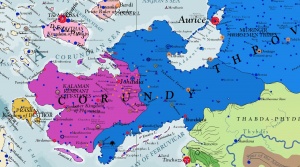
The Midrinksi Tribes of western Lucacia entered in successive waves into eastern Kalama around the eighth century before Salmakhamer. Midrinksi tribes through conquest and settlement spread from Lucacia into eastern Corundy and thence to central and western Corundy by the time of Salmakhamer. For the next eight hundred years, the Midrinksi tribes dwelt alongside the remnants of Kalaman civilization that persist to this day. Midrinksi city-states expanded their power through these centuries through conquest and treaty. A blending of Midrinksi and Kalaman culture established the foundation of later Midretassene Civilization, with great honor given to the much more ancient Kalaman contribution. In the early second century before Salmakhamer, the Midrinksi city-state of Flampesha, united all of eastern Corundy. By the mid second century before Salmakhamer, the Jaithan power of the city-state of Cetibrymio (Kathyabrumya), came to conflict with Flampesha. The two cities eventually united, combining the military power of the Midrinksi tribes with the religious and scientific knowledge of the Jaithan people into the core state that became Midretasso. By the time of the first century after Salmakhamer, Midretasso had united all of the Corundian Peninsula under the rule of the first Over-King, Uturnus. Ancient Midretassenes developed a powerful empire that spread rulership throughout the Corundian peninsula, Lucacia, Ithatia, the Shadevan Delta, Agogia, western Erserce, and Dúrandwor. Midretassenes employed a well organized military and wielded powerful necromancy. In 287 AI, the Midretassene Navy defeated the Elystrine Navy in the Battle of Deliopian Strait. In 415 AI, the Midretassene army defeated an alliance of Moigthe in southern Pytharnia in the Battle of Curchása, thus securing Midretassene control of Dúrandwor. By the late fifth century, Midretasso came up against the power of the Yophenthean Empire, with both empires striving to exert greater influence over the Moigthe Tribes of Pytharnia. In 513 AI, the Battle of Siul saw the Yophenthean defeat of the Midretassene Empire and marked the beginning of the decline and conquest of Midretasso in the same century.
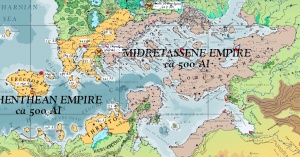
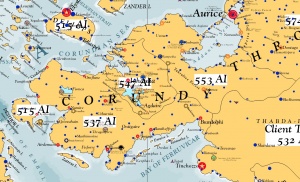
Chronology of Midretasso
TO BE REWORKD
- 8th century AS Midrinksi tribes immigrate into the Kalaman Peninsula
- 2nd century AS Midrinksi Flampesha conflicts with Cetibrymio
- 1st century AS, Cetibrymio becomes capital of united peninsula, becomes the core of the future Midretassene Empire
- 53 AI, establishment of the Over-King of Midretasso
- 287 Battle of Deliopian Strait, Midretasso conquers Deliops and the Ithatian isles
- 415 Battle of Curchása, Midretasso ensures its prolonged rule of Dúrandwor.
- 469 Battle of Danallo, Yophenthean defeat of Moigthe power in southwestern Pytharnia as part of the ongoing struggle between Yophenthea and Midretasso for control of Pytharnia.
- 513 Battle of Siul
- 515 Yophenthean Conquest of Deliops and Desthor
- 537 Yophenthean Conquest of western Corundy
- 547 Yophenthean Conquest of the Vimalian Plateau
- 553 Yophenthean Conquest of Tassan Plateau (eastern Corundy) and southwestern Lucacia
Midretassene Language
The Tassan Language is the direct descendant of the ancient Midretassene Language. The Lucacian Language is related to Tassan and Midretassene as all these languages descended from the ancient language of the Midrinksi Tribes. Unlike the Kalaman Language which is a Jathya-Dhumi tongue, Midretassene is derived from the Gwenyan Language Family and is distantly related to Ersercese, Ithatian, and other Gwenyan languages. The Midretassene Language borrowed many words from ancient Kalaman that were then disseminated to other languages like Dúrandworese and Lucacian. The modern Dúrandworese Language has a strong borrowing of words from ancient Midretassene due to the period of Midretassene rule. Midretassene is no longer spoken, but is studied by scholars and librarians. The modern Jaithan Language which is descended from the Kalaman Language has some borrowings from Midretassene.
Necromancy in Ancient Midretasso
Midretasso is often commonly remembered today for its practice of necromancy. The Midretassene Empire did not originally approve of necromancy, but many practitioners adopted necromancy from the Vimalian necromancers whose tradition stemmed back many centuries to the time of the plague zombies used in battle against the ancient Neptultchi. Vimalians eventually reduced the practice of necromancy to near extinction, but the Midretassenes accepted it begrudgingly and ultimately employed it in warfare. The Midretassene tolerance of necromancy was one of the reasons that ancient Yophentheans cited to justify their conquest of the Midretassene Empire.
Religion of Ancient Midretasso
Midretassenes worshiped their own pantheon of Isxinthion Gods. They also worshiped various lesser diabolic divinities. Additional divinities and practices were drawn from the nomadic steppes and Kalama.
See Also
| This article is a stub. It requires further development by the creator. |
